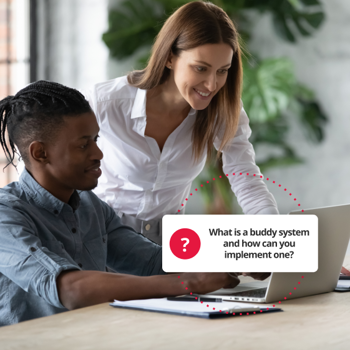
What is a buddy system?
A buddy system at work pairs a new employee with an existing team member who provides support and guidance in relation to their role, as well as insights into the overall company culture. The goal is to help new hires to feel welcome and confident in their roles.
Unlike traditional training, buddy systems focus on peer support rather than formal instruction. The buddy is not a manager but a colleague who offers practical advice and answers questions, making the onboarding process more engaging and less intimidating.
What does a buddy do?
A buddy plays a crucial role in making new employees feel comfortable and prepared. Their key responsibilities include:
- Introducing the new hire to colleagues and company culture
- Answering questions about daily tasks and workplace procedures
- Providing guidance on workplace norms and expectations
- Encouraging social interaction and inclusion within the team
- Acting as a point of contact for any concerns or challenges
- Helping the new hire to navigate company systems and tools
What’s the difference between a buddy and a mentor?
A mentor is usually a more senior employee who provides long-term career guidance, helping employees to develop professionally over time. Mentors focus on personal growth, goal setting and industry insights, and their knowledge-sharing process may be more formal.
A work buddy system, on the other hand, focuses more on the needs of the current role through peer-to-peer learning. Buddies assist new hires with settling into their roles, understanding daily tasks and integrating into the team. While mentorship is ongoing, the buddy system offers short-term support to make onboarding smoother.
The benefits of buddy systems
Implementing a work buddy system provides several advantages for both employees and businesses. Let’s explore these in more detail.
Supports employee onboarding
Structured buddy systems enhance employee onboarding by ensuring that new hires feel supported from their very first day. Having a designated person to turn to helps to alleviate uncertainty and creates a smoother transition into the company.
Enhances the learning experience
Learning on the job becomes easier when new employees have a go-to person for questions. A buddy system at work fosters continuous personal development by allowing new hires to learn from experienced colleagues in a low-pressure environment.
Increases productivity
New employees take time to reach full productivity, but a work buddy system speeds up this process. Buddies provide quick answers to questions, reducing downtime and enabling new hires to contribute to the company sooner. It also increases employee productivity by freeing up managers to focus on other critical business tasks.
Creates stronger relationships
Buddy systems help new employees to integrate socially within the company by giving them someone to talk to freely from day one. Peer-to-peer learning is less intimidating than formal training, encouraging open communication and fostering stronger workplace relationships.
Step-by-step guide to implementing a buddy system at work
If you’re considering implementing a buddy system at work, it’s important to use a strategic approach to maximise the benefits for employers and employees alike. We’ve put together a guide to help you set up and optimise your work buddy system.
1. Choose suitable employees to act as buddies
Not every employee is suited to being a buddy. Good buddy system candidates should be approachable, knowledgeable and willing to help others. They should also demonstrate strong autonomy at work, allowing them to balance guiding new hires with maintaining their own productivity.
2. Match new hires with the right buddies
Pairing employees based on personality, experience and working style is essential to ensure the best results. A buddy doesn’t always have to be in the same department, but they should understand the company culture and job expectations well enough to offer valuable guidance.
3. Guide buddies on their responsibilities
Buddy systems work best when buddies know what is expected of them. Providing a checklist aligned with your employee onboarding process ensures that they cover key aspects, from explaining essential processes to introducing new hires to the social side of the workplace.
4. Regularly review your buddy system
Regular feedback from both buddies and new hires helps to refine the system over time. Check-ins and performance appraisals can highlight areas for improvement, ensuring that your work buddy system remains effective and relevant.
Support your employees with PeopleHR
A well-structured buddy system at work can significantly improve employee experiences, from facilitating smoother onboarding to building stronger workplace relationships. By carefully selecting and guiding buddies, businesses can create a supportive environment that enhances engagement and productivity.
Our purpose-built HR software simplifies the implementation of buddy systems by streamlining onboarding and employee engagement processes through automated processes, self-service functionality and more. To learn more about how our solutions can support your business, book a demo or contact our team today.
